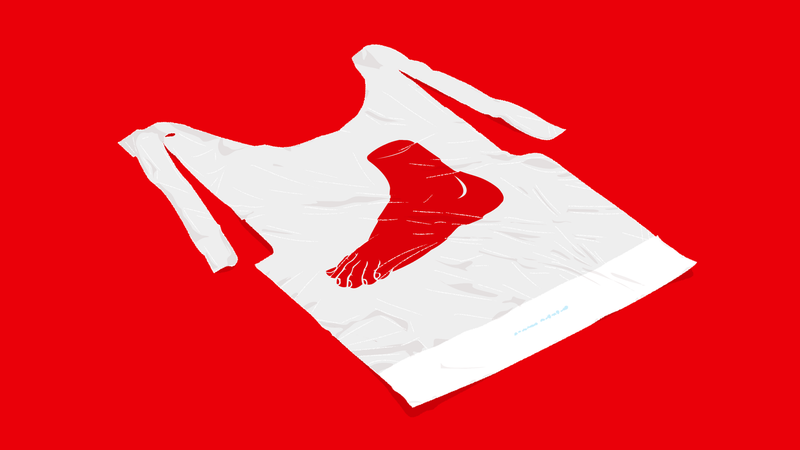
Dear Leigh,
I’ve tasted the skin that I’ve peeled from my feet after using Baby Foot. I know it’s so gross but the whole experience is cathartic. But like, how gross is it?
Dearest Sole Snacker,
Once upon a time, a friend of mine was waiting to checkout at a big chain grocery store when she noticed a man with a golden mullet and a vermillion sunburn. Being the fearless woman she is, never one to miss an opportunity, she approached this specimen of pure Florida Man aesthetic and asked him one, simple question: Can I peel your back?
He said yes.
Right there, in the store, she slipped her hands beneath the straps of his tank top and took the skin as if to unspool a sacred text, using her index and middle fingers to ease the man away from himself. His back skin came off in one, translucent piece. Elated, she told me that if it had been her own skin, she would have gently volleyed the skin into the air and caught it with her open mouth, like a koi sucking up flakes of fish food.
What I’m saying is that you aren’t alone, Sole Snacker. Really, it’s not that big a deal. The emotional narratives people craft around body parts define what is socially acceptable to stick in your mouth. Chewing through cuticles at the DMV is fine; noshing on a big toenail while waiting for a driving test, less so.
Presumably, feet are classed as “gross” because people walk on them and, by extension, step in everything from rat piss to bachelorette party emesis. If you’re a barefoot hippie strolling along on two inch calluses over July asphalt, then yes, your feet are probably gross. But a lot of us stick our clean feet into clean socks and traipse around with a protective covering between us and the filth of communal living. By this logic, it would seem less gross to chew off your foot calluses than to eat your cuticles, since hands do things like wipe anuses and touch door handles. Just something to think about!
Your callus-tasting falls under autophagia, the technical term for eating one’s own body. (It’s also the name of a grindcore band, obviously.)
According to the Diagnostic and Statistical Manual of Mental Disorders (DSM), autophagia is neither a mental disorder itself nor is it a symptom of one. That said, there’s a big difference between idly nibbling on a cuticle and compulsively eating all of your fingertips clean off. As such, there’s enough wiggle room in the DSM for harmful autophagia to fall under Impulse-Control Disorders Not Elsewhere Classified, an umbrella term for urges that are inelegantly sorted but nonetheless require treatment.
I am going to take this to mean that, broadly-speaking, eating your own skin is fine. So, what the fuck is a person actually eating when they chomp some post-peel skin?
First, a note on the popular foot peel you used, dear Sole Snacker. For those unaware, the peel in question, known as Baby Feet, is a cursed beauty product. Just straight up Cronenbergian nightmare fuel.
Here’s how it works. A few days after applying the acidic goo to the feet, all of the dead foot skin begins to peel off in great sheets, calluses popping off heels like cup-shaped magnolia petals opening in bloom, revealing skin as soft and useless as a baby. The acids work like a chemical peel, penetrating the top layers of skin and breaking up the desmosomes that essentially glue dead skin cells together. The skin is in a constant state of making new cells and pushing them to the surface; dead cells fall away as they are no longer needed, about eight pounds worth per year. In the case of a callus, repeated pressure and friction can cause an increase in keratin production. This is a protective response, thickening the skin to compensate for the extra stress. Add some acids, break the bonds that attach the dead skin to the living, peel that bad boy off, and voilá: snack time.
Listen, plenty of creatures eat their skin after shedding it. Take it from vertebrate zoologist and biology professor Bill Schutt. “I believe it’s quite common in reptiles and some amphibians, where there’s obviously some nutritional benefit [to eating their skin].” The list of skin snackers cashing in on this boost includes frogs, toads, salamanders, lizards, coconut crabs, and many types of insects, to name a few.
But my favorite skin eaters are the caecilians, specifically Boulengerula tatiana, which is why I emailed Schutt, who wrote about them at length in his book on intraspecies dining, Cannibalism: A Perfectly Natural History.
Pronounced like Sicilian, caecilians look like fucking snakes but are definitely not snakes. Rather, they are legless amphibians. Obviously this is enough to make them cool, as shady animals are always cool, but B. tatiana takes things a step further in the skin-eating department.
“The epidermis of an egg-laying mother caecilian that has just given birth is laden with nutrient-rich compounds used to feed the babies that consume it.” That is, the babies peel and eat their mom. Mama caecilian has special, nutritious skin that her offspring use a special tooth to tear off and eat. She then regrows her tasty skin and the babies can feed anew. “The phenomenon is fascinating for many reasons, one being the fact that this is basically a form of parental care similar to that of mammals and their mammary glands—though of course this occurs via a very different mechanism.” As someone who breastfed a voracious lamprey of a baby, I feel camaraderie in the maternal investment department. It’s hard to be the food-maker, be it skin or secretions.
But anyway, my point is this: Nature has spoken. Skin is delicious.
source:-adequateman.deadspin
